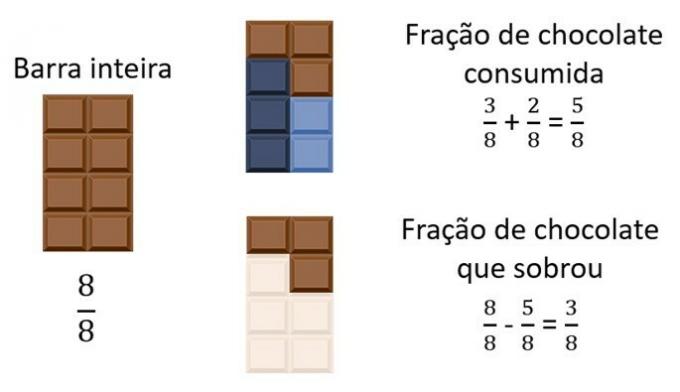The Multiplication and Division of Fractions are operations that, respectively, simplify the sum of numerators and represent the parts of a whole, that is, of an integer.
They can be done using two rules. Let's go to them!
It is important to remember that in fractions, the upper term is called the numerator while the lower term is called the denominator.
Fraction Multiplication
When multiplying fractions, simply multiply one numerator by another and then one denominator by another.
Example:
Multiplication is done this way regardless of the number of fractions.
Example:
How to do in the case below? Simple. You have at least three options:
1.ª
2.ª
3.ª
Check out this content in more detail at: Fraction Multiplication.
Division of Fractions
At division of fractions the rule is as follows:
1st The numerator of the first fraction multiplies the denominator of the second;
2. The denominator of the first fraction multiplies the numerator of the other fraction.
Example:
As in multiplication, also in division the rule applies regardless of the number of fractions, ie:
1st The numerator of the first fraction multiplies the denominator of the second and the remaining fractions;
2. The denominator of the first fraction multiplies the numerator of all other fractions.
Example:
See also other operations with fractions: Addition and Subtraction of Fractions.
Solved exercises of multiplication and division of fractions
Now that you've learned how to multiply and divide fractions, test your knowledge:
question 1
Determine the result of the operations below.
The)
B)
ç)
d)
Correct answers: a) 1, b) 2/7 c) 6 and d) 1/8.
The)
When the result of the multiplication of two fractions gives the result 1, it means that the fractions are inverse of each other, that is, the inverse fraction of 2/3 is 3/2.
So 2/3 times 3/2 is equal to 1.
B)
Another way to solve this multiplication is to cancel the similar term.
Note that fractions have the same factor in the numerator and denominator. In this case, we can cancel them by dividing both by the number itself, ie 3.
So 2/3 times 3/7 is equal to 2/7.
c) In the division operation, we must multiply the first fraction by the inverse of the second fraction, that is, multiply the numerator of the first by the denominator of the second and multiply the denominator of the first by the numerator of the Monday.
So 3/5 divided by 1/10 equals 6.
d) In this example we have the division of a fraction by a natural number. To solve it, we must multiply the first by the inverse of the second.
Note that the number 2 does not have the denominator written, that is, we have the number 1 as the denominator and we can invert the fraction as follows: the inverse of 2 is 1/2.
We then solved the operation.
So the 1/4 half is 1/8.
question 2
If a pot contains 3/4 kilogram of chocolate milk, how many kg of chocolate milk would have 8 pots equal to this?
a) 4 kg
b) 6 kg
c) 2 kg
Correct answer: b) 6 kg.
In this situation we have the multiplication of a fraction by a natural number.
To solve it we must multiply the natural number by the numerator of the fraction and repeat the denominator.
If each pot has 3/4 kg of chocolate milk, 8 pots would have a total of 6 kg.
question 3
In the pantry at her house, Maria noticed that she had four packages with half a kg of rice and 6 packages with a quarter of a kilo of noodles. What was in the greatest amount?
a) Rice
b) Pasta
c) In the pantry there was the same amount of both
Correct answer: a) Rice.
First, let's calculate the amount of rice. Remember that a pound is 1/2, because 1 divided by 2 is 0.5.
Now, we calculate the amount of noodles.
Since the division of 6 by 2 is not an exact number, we can simplify the numerator and denominator by 2.
As the division of 3 by 2 results in 1.5 we concluded that rice is in greater quantity, as it has 2 kg.
question 4
In a classroom 2/3 of the students are girls. Among girls, 3/4 have brown hair. What fraction of the students in the class have brown hair?
a) 3/2
b) 1/2
c) 1/3
Correct answer: b) 1/2.
If in a class 2/3 of the total are girls and in that number 3/4 have brown hair, then we must calculate the product of two fractions.
We solve the multiplication of fractions by writing in the numerator the product of 2 by 3 and in the denominator the product of 3 by 4.
Note that 12 is double 6. We can simplify this fraction by dividing the numerator and denominator by 6.
Thus, 1/2, that is, half have brown hair.
For more questions, check outFraction Exercises.
question 5
When he got home, João found an open chocolate package on the table. There was 1/3 of the chocolate bar and he ate half that amount. How much chocolate did John eat?
a) 1/4
b) 1/5
c) 1/6
Correct answer: c) 1/6.
In the statement we have the information that João ate half of 1/3, that is, he divided 1/3 into two parts and ate only one. Therefore, the operation that must be performed is 1/3: 2.
To solve this question we must multiply the first fraction (1/3) by the inverse of the second fraction (2), that is, 1/3 multiplied by 1/2.
So João ate 1/6 of the chocolate bar.
knowmoreaboutOthemeUSarticles:
- What is fraction?
- Types of fractions and fractional operations
- Equivalent Fractions
- generating fraction
If you are looking for a text with an approach to early childhood education, read: Operation with fractions - Kids and Fractions - Kids.


